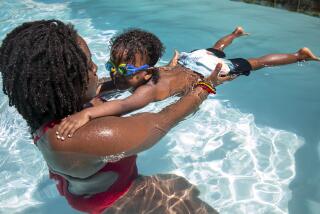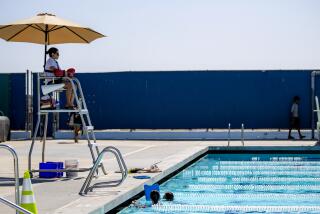COMMENTARY : Back-Yard Pools Will Kill, and Kill, and Kill, Until Tamed
- Share via
Another spring, another May, another drowning season in sunny Orange County.
Once again the Critical Care Transport Team gears up to make the late afternoon and weekend runs to local emergency rooms responding to the feared “near-drowning victim,” knowing that some young family’s worst fears have been realized, that a young child lies near death.
A look at the drowning data is certainly needed to illustrate the severity of the problem. We know that 12 to 14 young children die each year in Orange County in pools or spas, and we can expect another five to 10 children to live--but with severe lifelong brain damage.
Between 80 and 100 children will have major, near-drowning episodes. Here at Childrens Hospital of Orange County, we expect 40 to 45 near-drowned children over the year, 25% of whom will either die or suffer irreversible brain injury.
Drowning has surpassed auto accidents in California as the No. 1 accidental killer of young children; a child is 14 times as likely to die in a home pool as from a car accident.
But the numbers are cold and impersonal. No words can describe the fear written on the faces of the young parents in the emergency room or intensive care unit as their child’s life hangs in the balance, often for days.
Intense self-recrimination for having such a deadly trap in the back yard tears at their hearts. When baby-sitters or grandparents are involved, blame for the “accident” tears at family solidarity.
Make no mistake--near-drowning in children occurs primarily in home pools, where children feel safe and secure in their own friendly back yards. These are primarily 1- to 5-year-olds, mostly boys, at the height of their speed, curiosity and aggressiveness. A child drowns very fast (in just the time it takes to answer the phone or door), surprisingly silently and always unexpectedly.
No pool is safe, no child is “drown-proof.” No young child can be trusted to stay away from such an alluring and attractive hazard. There are no exempt economic groups; it can happen to you. Many children even drown in their grandparents’ pool.
Many of us have been struggling for years in various efforts to make home pools safer for young children. Notwithstanding the obvious impossibility of eliminating all home pools in Orange County, the primary deterrent is constant awareness of the dangers involved--and constant supervision of your child.
But we can also make pools safer at all times. Orange County has more than 100,000 home pools, and yet there is no uniform government policy toward the construction of safety barriers for them. This county cannot afford to continue to delay the implementation of a comprehensive swimming pool fencing law, such as the one Phoenix enacted this spring.
If an effective fencing ordinance were in place in all areas of Orange County, and all adult owners of pools had CPR skills, we could drastically reduce the death and disability caused by childhood drowning and near-drowning.
For fencing to be effective, it must surround the pool, not just the house, have a self-latching gate, be placed around all pools where small children live, not just new pools, and be inspected and certified periodically.
This will not be easy. A recent study from the Sacramento area surveyed 795 homes with pools. While most of the owners (86%) favored voluntary cardiopulmonary resuscitation training, only 40% favored required CPR courses. Also, although 51% favored fencing barriers on new pools, only 39% favored a universal fencing ordinance to include existing pools.
This apparent public misconception of the problem is a major hindrance to eliminating the hazard. The primary efforts in the past have been public education; it may be time to realize that education alone is not sufficient to modify the behavior of pool owners.
There is only one condition in intensive care units that incites more anger and frustration in the staff than near-drowning, and that is child abuse. The emotions are the same: anger that this has happened to an innocent, trusting, healthy child, and intense hostility toward an unknown and unseen adult for letting it happen.
Near-drowning is preventable; each case is preventable. For every child who has drowned, or nearly drowned, there is an adult who has been shortsighted or negligent, even utterly irresponsible. It simply is ludicrous to think that a pool in your back yard and babies in your house can peacefully coexist. You might as well let them play in the street with a loaded gun, an action that would surely get you arrested.
Think of your little ones before you buy that house with a pool, or before you have that pool installed, and strongly consider delaying that purchase until your youngest child is older than age 5.
If you have a pool, fence it, cover it, even drain it--but don’t ignore it. Besides being a hole in your back yard in which you throw money, it can instantly snatch your most valuable possession, the life of your child.
More to Read
Sign up for Essential California
The most important California stories and recommendations in your inbox every morning.
You may occasionally receive promotional content from the Los Angeles Times.













